Wenjun Wu
RLLaVA: An RL-central Framework for Language and Vision Assistants
Dec 25, 2025Abstract:We present an RL-central framework for Language and Vision Assistants (RLLaVA) with its formulation of Markov decision process (MDP). RLLaVA decouples RL algorithmic logic from model architecture and distributed execution, supporting researchers in implementing new RL algorithms with minimal code, and to plug in a broad family of RL methods and vision-language models (VLMs) while remaining agnostic to specific training and inference engines. RLLaVA makes resource-efficient training of 1B--7B models feasible on common GPUs; notably, 4B-scale models can be trained end-to-end with full-parameter updates on a single 24GB GPU. Experiments on multi-modal and agentic tasks demonstrate that RLLaVA has task extensibility, and the models trained with it consistently improve performance over base models, competitive with other specially engineered RL frameworks. The code is available at https://github.com/TinyLoopX/RLLaVA.
Tool-Augmented Hybrid Ensemble Reasoning with Distillation for Bilingual Mathematical Problem Solving
Dec 22, 2025Abstract:Bilingual mathematical problem solving needs a clear link between language reasoning and symbolic calculation. Large language models often handle language well but are weak in accurate computation. This paper presents HERALD (Hybrid Ensemble Reasoning with Adaptive Learning and Distillation), a framework that joins reasoning and calculation using NuminaMath-7B-TIR, GPT-4o, and Mistral-7B. HERALD uses adaptive routing, tool-based reinforcement learning, and knowledge distillation to connect different reasoning paths. Confidence calibration keeps weighting stable, and dual-path checking keeps results correct. Reinforcement learning controls tool use to cut redundancy, and distillation lowers delay without hurting accuracy. The system shows that combining symbolic checking, adaptive ensembles, and bilingual fine-tuning helps achieve both fluent reasoning and precise calculation. HERALD offers a practical solution for multilingual mathematical reasoning with better accuracy, stability, and clarity.
UrbanNav: Learning Language-Guided Urban Navigation from Web-Scale Human Trajectories
Dec 10, 2025Abstract:Navigating complex urban environments using natural language instructions poses significant challenges for embodied agents, including noisy language instructions, ambiguous spatial references, diverse landmarks, and dynamic street scenes. Current visual navigation methods are typically limited to simulated or off-street environments, and often rely on precise goal formats, such as specific coordinates or images. This limits their effectiveness for autonomous agents like last-mile delivery robots navigating unfamiliar cities. To address these limitations, we introduce UrbanNav, a scalable framework that trains embodied agents to follow free-form language instructions in diverse urban settings. Leveraging web-scale city walking videos, we develop an scalable annotation pipeline that aligns human navigation trajectories with language instructions grounded in real-world landmarks. UrbanNav encompasses over 1,500 hours of navigation data and 3 million instruction-trajectory-landmark triplets, capturing a wide range of urban scenarios. Our model learns robust navigation policies to tackle complex urban scenarios, demonstrating superior spatial reasoning, robustness to noisy instructions, and generalization to unseen urban settings. Experimental results show that UrbanNav significantly outperforms existing methods, highlighting the potential of large-scale web video data to enable language-guided, real-world urban navigation for embodied agents.
What Color Is It? A Text-Interference Multimodal Hallucination Benchmark
Nov 19, 2025Abstract:With the rapid advancement of Large Models, numerous text-and-vision-fused Multimodal Large Models (MLMs) have emerged. However, these MLMs remain susceptible to informational interference in visual perception, particularly in color perception, which introduces an additional risk of hallucination. To validate this hypothesis, we introduce the "What Color Is It" dataset, a novel benchmark constructed using a simple method to trigger single-modality visual hallucination in MLMs. Based on this dataset, we further investigate the underlying causes of hallucination in the visual modality of MLMs and propose potential solutions to enhance their robustness.
C-NAV: Towards Self-Evolving Continual Object Navigation in Open World
Oct 23, 2025Abstract:Embodied agents are expected to perform object navigation in dynamic, open-world environments. However, existing approaches typically rely on static trajectories and a fixed set of object categories during training, overlooking the real-world requirement for continual adaptation to evolving scenarios. To facilitate related studies, we introduce the continual object navigation benchmark, which requires agents to acquire navigation skills for new object categories while avoiding catastrophic forgetting of previously learned knowledge. To tackle this challenge, we propose C-Nav, a continual visual navigation framework that integrates two key innovations: (1) A dual-path anti-forgetting mechanism, which comprises feature distillation that aligns multi-modal inputs into a consistent representation space to ensure representation consistency, and feature replay that retains temporal features within the action decoder to ensure policy consistency. (2) An adaptive sampling strategy that selects diverse and informative experiences, thereby reducing redundancy and minimizing memory overhead. Extensive experiments across multiple model architectures demonstrate that C-Nav consistently outperforms existing approaches, achieving superior performance even compared to baselines with full trajectory retention, while significantly lowering memory requirements. The code will be publicly available at https://bigtree765.github.io/C-Nav-project.
Erased, But Not Forgotten: Erased Rectified Flow Transformers Still Remain Unsafe Under Concept Attack
Oct 01, 2025Abstract:Recent advances in text-to-image (T2I) diffusion models have enabled impressive generative capabilities, but they also raise significant safety concerns due to the potential to produce harmful or undesirable content. While concept erasure has been explored as a mitigation strategy, most existing approaches and corresponding attack evaluations are tailored to Stable Diffusion (SD) and exhibit limited effectiveness when transferred to next-generation rectified flow transformers such as Flux. In this work, we present ReFlux, the first concept attack method specifically designed to assess the robustness of concept erasure in the latest rectified flow-based T2I framework. Our approach is motivated by the observation that existing concept erasure techniques, when applied to Flux, fundamentally rely on a phenomenon known as attention localization. Building on this insight, we propose a simple yet effective attack strategy that specifically targets this property. At its core, a reverse-attention optimization strategy is introduced to effectively reactivate suppressed signals while stabilizing attention. This is further reinforced by a velocity-guided dynamic that enhances the robustness of concept reactivation by steering the flow matching process, and a consistency-preserving objective that maintains the global layout and preserves unrelated content. Extensive experiments consistently demonstrate the effectiveness and efficiency of the proposed attack method, establishing a reliable benchmark for evaluating the robustness of concept erasure strategies in rectified flow transformers.
Symmetry-Guided Multi-Agent Inverse Reinforcement Learning
Sep 11, 2025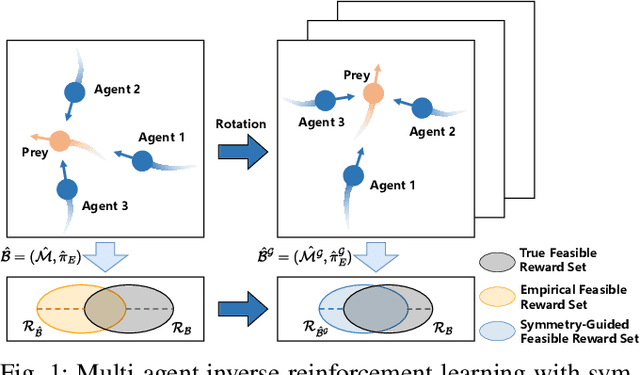
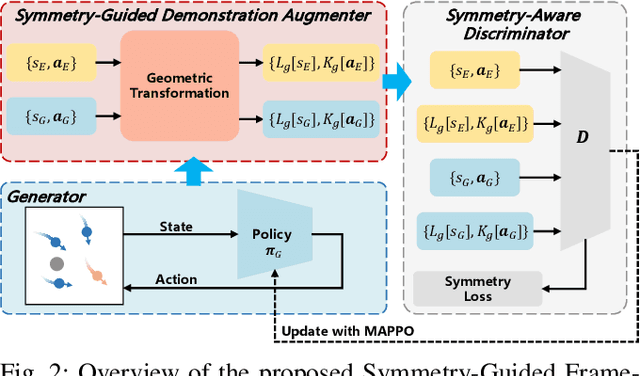

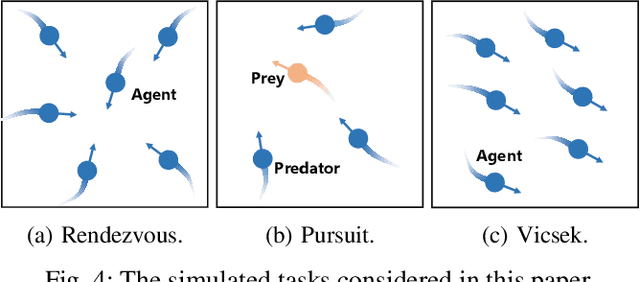
Abstract:In robotic systems, the performance of reinforcement learning depends on the rationality of predefined reward functions. However, manually designed reward functions often lead to policy failures due to inaccuracies. Inverse Reinforcement Learning (IRL) addresses this problem by inferring implicit reward functions from expert demonstrations. Nevertheless, existing methods rely heavily on large amounts of expert demonstrations to accurately recover the reward function. The high cost of collecting expert demonstrations in robotic applications, particularly in multi-robot systems, severely hinders the practical deployment of IRL. Consequently, improving sample efficiency has emerged as a critical challenge in multi-agent inverse reinforcement learning (MIRL). Inspired by the symmetry inherent in multi-agent systems, this work theoretically demonstrates that leveraging symmetry enables the recovery of more accurate reward functions. Building upon this insight, we propose a universal framework that integrates symmetry into existing multi-agent adversarial IRL algorithms, thereby significantly enhancing sample efficiency. Experimental results from multiple challenging tasks have demonstrated the effectiveness of this framework. Further validation in physical multi-robot systems has shown the practicality of our method.
Can Structured Templates Facilitate LLMs in Tackling Harder Tasks? : An Exploration of Scaling Laws by Difficulty
Aug 26, 2025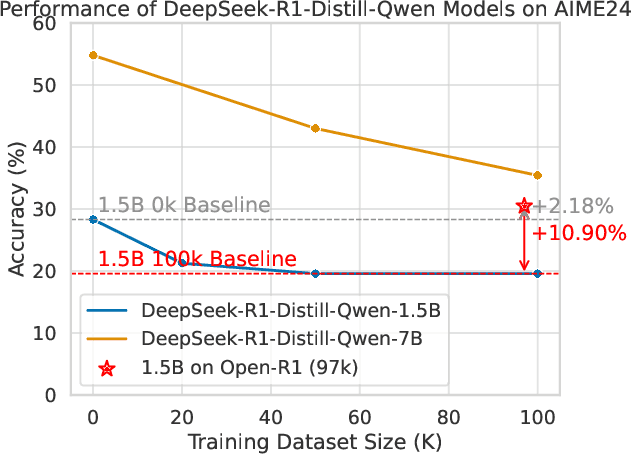

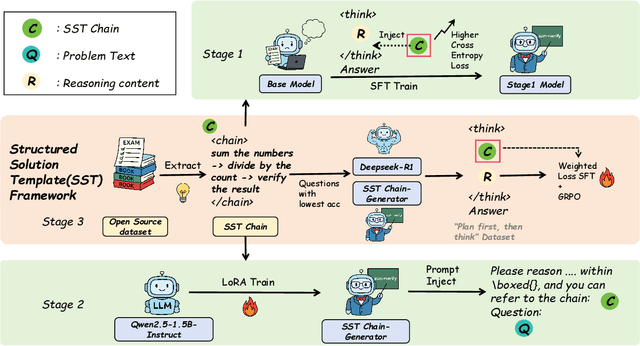

Abstract:Structured, procedural reasoning is essential for Large Language Models (LLMs), especially in mathematics. While post-training methods have improved LLM performance, they still fall short in capturing deep procedural logic on complex tasks. To tackle the issue, in this paper, we first investigate this limitation and uncover a novel finding: a Scaling Law by Difficulty, which reveals that model performance follows a U-shaped curve with respect to training data complexity -- excessive low-difficulty data impedes abstraction, while high-difficulty data significantly enhances reasoning ability. Motivated by this, we propose the Structured Solution Template (SST) framework, which uses solution templates and a curriculum of varied difficulty to explicitly teach procedural reasoning. Specifically, SST comprises (1) fine-tuning with structured solution-template chains and dynamically weighted loss to prioritize procedural logic, (2) prompt-time injection of solution templates as cognitive scaffolds to guide inference, and (3) integrated curriculum fine-tuning that explicitly teaches the model to self-plan - execute - self-correct. Experiments on GSM8K, AIME24, and new Dynamic En benchmark show that SST significantly improves both accuracy and efficiency, especially on harder problems.
Neural Algorithmic Reasoners informed Large Language Model for Multi-Agent Path Finding
Aug 25, 2025Abstract:The development and application of large language models (LLM) have demonstrated that foundational models can be utilized to solve a wide array of tasks. However, their performance in multi-agent path finding (MAPF) tasks has been less than satisfactory, with only a few studies exploring this area. MAPF is a complex problem requiring both planning and multi-agent coordination. To improve the performance of LLM in MAPF tasks, we propose a novel framework, LLM-NAR, which leverages neural algorithmic reasoners (NAR) to inform LLM for MAPF. LLM-NAR consists of three key components: an LLM for MAPF, a pre-trained graph neural network-based NAR, and a cross-attention mechanism. This is the first work to propose using a neural algorithmic reasoner to integrate GNNs with the map information for MAPF, thereby guiding LLM to achieve superior performance. LLM-NAR can be easily adapted to various LLM models. Both simulation and real-world experiments demonstrate that our method significantly outperforms existing LLM-based approaches in solving MAPF problems.
GeoLaux: A Benchmark for Evaluating MLLMs' Geometry Performance on Long-Step Problems Requiring Auxiliary Lines
Aug 08, 2025Abstract:Geometry problem solving (GPS) requires models to master diagram comprehension, logical reasoning, knowledge application, numerical computation, and auxiliary line construction. This presents a significant challenge for Multimodal Large Language Models (MLLMs). However, existing benchmarks for evaluating MLLM geometry skills overlook auxiliary line construction and lack fine-grained process evaluation, making them insufficient for assessing MLLMs' long-step reasoning abilities. To bridge these gaps, we present the GeoLaux benchmark, comprising 2,186 geometry problems, incorporating both calculation and proving questions. Notably, the problems require an average of 6.51 reasoning steps, with a maximum of 24 steps, and 41.8% of them need auxiliary line construction. Building on the dataset, we design a novel five-dimensional evaluation strategy assessing answer correctness, process correctness, process quality, auxiliary line impact, and error causes. Extensive experiments on 13 leading MLLMs (including thinking models and non-thinking models) yield three pivotal findings: First, models exhibit substantial performance degradation in extended reasoning steps (nine models demonstrate over 50% performance drop). Second, compared to calculation problems, MLLMs tend to take shortcuts when solving proving problems. Third, models lack auxiliary line awareness, and enhancing this capability proves particularly beneficial for overall geometry reasoning improvement. These findings establish GeoLaux as both a benchmark for evaluating MLLMs' long-step geometric reasoning with auxiliary lines and a guide for capability advancement. Our dataset and code are included in supplementary materials and will be released.
 Add to Chrome
Add to Chrome Add to Firefox
Add to Firefox Add to Edge
Add to Edge